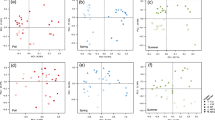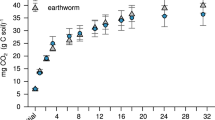Abstract.
Earthworms are a major component of many terrestrial ecosystems. By modifying decomposition processes and soil structure, they function as driving factors of the soil microbial community. Using microcosms, we investigated the effects of the presence and community composition of earthworms on the in situ respiratory response of a microbial community to an array of organic substrates including carbohydrates, amino acids, a polymer and an amide. Both the actual in situ catabolic response of non-growing microorganisms and the potential response of growing microorganisms were investigated. Three questions were studied: (1) does the presence of one of the main functional groups of earthworms (endogeic species) affect microbial community functioning; (2) does the presence of two functional groups (endogeic and epigeic species) alter microbial community functioning; (3) does the number of species within functional groups matter. The presence of endogeic earthworms significantly reduced microbial biomass and affected the physiological profile and functioning of the microbial community. In contrast, in the presence of endo- and epigeic species microbial biomass was not reduced significantly, indicating that epigeic species counteracted the effect of endogeic species. The physiological profile of the microbial community significantly differed between the treatment with endogeic species only and the treatment with both endo- and epigeic species. Also, the physiological profile of the microbial community was significantly affected by the number of species per functional group, which at least in part may have been caused by a sampling effect. Overall, the actual in situ catabolic response of non-growing microorganisms appears to be more sensitive than the potential response of growing microorganisms. In addition, the direction of the actual response (negative) was diametrically opposed to that of the potential response (positive). We conclude that the catabolic response of growing microorganisms does not reflect the actual case in situ. For earthworms, loss in both species number and functional group number has the potential to change soil microbial community functioning.
Similar content being viewed by others
Author information
Authors and Affiliations
Corresponding author
Additional information
Electronic Publication
Rights and permissions
About this article
Cite this article
Scheu, S., Schlitt, N., Tiunov, A.V. et al. Effects of the presence and community composition of earthworms on microbial community functioning. Oecologia 133, 254–260 (2002). https://doi.org/10.1007/s00442-002-1023-4
Received:
Accepted:
Published:
Issue Date:
DOI: https://doi.org/10.1007/s00442-002-1023-4




